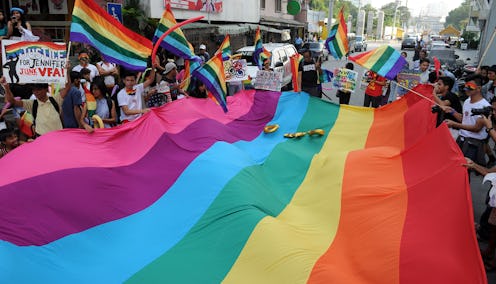Life
Words To Know When Discussing Gender And Sexuality
As the world becomes more aware of issues surrounding gender and sexuality, it's important also to be aware of the vocabulary that's commonly used in relation to these issues — and, perhaps more importantly, how to correctly use those words when talking about gender and sexuality. We've covered this topic before on Bustle; different vocabulary words have risen to the fore in the intervening years in different ways, though, so it's necessary to keep your arsenal of jargon updated in order to have well-informed conversations about issues that are gaining in much-needed visibility.
Many peoples' understanding of gender and sexuality are limited to the L, G, B, and T letters that make up the LGBT acronym (and some people might still be a little iffy on the T). But there's so much more when it comes to talking about these issues, and even the acronym LGBT is starting to become outdated and replaced by LGBTQIA (the Q, I, and A representing queer/questioning, intersex, and asexual). It's important to call people's attention to these vocabulary words not only for the purpose of shedding some light on them, but to also correct the ways people have been using the words. The incorrect use of words related to gender and sexuality can be very harmful to certain groups of people, and we all deserve the respect of these words being used correctly.
So without further ado, here are seven words to know and refresh yourself on when talking about gender and sexuality.
1. Androgynous
After a lot of research, I found that the Agnes Scott College Queer Theory blog has probably the clearest definition of androgyny: That is, "having the characteristics or nature of both male and female; neither specifically feminine nor masculine; suitable to or for either sex." The word androgyny can apply to someone's aesthetic, gender presentation, or gender identity, and doesn't have to be limited to the binary. Though the word has a flexible definition, it's worth avoiding it as a way to describe a "gender swap." For example, just because a woman is masculine doesn't necessarily mean she's androgynous — and just because someone's androgynous doesn't mean they necessarily adopt the qualities of the opposite sex. Androgyny is it's own identity. Ruby Rose is an example of a pop culture icon who has androgynous fashion.
2. Asexual
At its core, asexuality means "someone who doesn't experience sexual attraction." But, like any other identity, there are nuances that are important to acknowledge. The website whatisasexuality.org clarifies some of these nuances and sheds light on some misconceptions. Asexuality, for example, doesn't necessarily mean celibacy or abstinence, even though there are celibate and abstinent asexual people. Asexuality is also not, in and of itself, a fear of sex or relationships or a mental disorder. Most importantly, asexual people do have romantic relationships with other people.
3. "Assigned At Birth"
When talking about trans or gender nonconforming people, news outlets (and people) will often make the mistake of saying that someone was "born a woman" or "born male." The more accurate way to talk about that topic, however, is to say, "[person] was assigned [male/female] at birth." Even that wording can sometimes be tricky, though; saying someone was "assigned to be a woman" at birth isn't as accurate as "assigned the female sex," because "male" and "female" are used to describe biological sex, while "woman" and "man" are used to talk about gender. Conflating sex with gender identity is simply inaccurate.
4. Cisgender
A cisgender person is someone whose assigned-at-birth sex corresponds with their gender identity; or, as GLAAD puts it, a non-transgender person or someone who is not transgender, with its roots in the Latin prefix "cis" or "on the same side as." This is a really important word to know, especially when understanding things like cis privilege.
5. Gender Binary
Imagine a scale, with "man" on one end and "woman" on the other. Many people think you can only be one end or the other — that is, they think of gender as a binary, or an either/or situation — but the slider on that scale can actually fall on any of the points between those two ends, or leave the scale entirely and fall somewhere outside of it. The gender binary erases the existence of trans, gender non-conforming, agender, or genderqueer identities. But gender isn't a binary, and it's dangerous to treat it like it is.
6. Heteronormative
This word can be a little tricky, so bear with me. Everyday Feminism describes heteronormativity as a "system that works to normalize behaviors and societal expectations that are tied to the presumption of heterosexuality and an adherence to a strict gender binary." That's a lot of words, but it's easier to boil it down to a real-life scenario: In my experience, whenever I tell people I'm a lesbian or introduce my girlfriend, they're likely to ask, "Who's the man in the relationship?" Of course, no one is the man in my lesbian relationship; however, the script of the heteronormative world we live in tries to shoehorn a lesbian couple into traditionally male and female roles. When one or more people don't adhere to those roles... well, you can see how it gets really problematic, really quickly.
7. Ze/Hir
These are perhaps the simplest vocab words on this list to define: Ze and hir are simply alternate, non-gendered pronouns that take the place of he/his/him or she/her/hers. Some gender nonconforming people prefer to use non-gendered pronouns like these ones, although some also use they/their/theirs or other alternatives. The important thing to note here is always to use the pronouns each individual prefers, rather than to misgender them by using pronouns with which they don't identify.
For more LGBTQA+ stories, check out Bustle on YouTube.
Images: Giphy (7)
